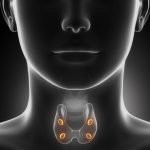Endometriosis: Preserving Fertility By Treating It Holistically
Amy Day, ND
When a woman presents to her allopathic doctor seeking help for managing her endometriosis (endo), nearly every treatment offered to her will impair her fertility. Hysterectomy, hormonal contraceptives, levonogestrel-releasing-IUD, and leuprolide injections are all poor choices for women who may want to become pregnant soon.
Approximately one-third of women with endo already have reduced fertility1; many of these women want to pursue trying to conceive while also needing to manage their pain and other symptoms.
Many women who express concerns about fertility are told to start trying immediately, yet their doctors often don’t even stop to consider whether the women are ready for this in their personal lives. Frequently, they aren’t given any good options for helping with their pain in the meantime. For those women who do start trying to conceive, the cruel irony is that dypareunia (painful intercourse) is a very common symptom of endo, hence making this a difficult and challenging time.
In advanced cases where women have severe endo or known infertility, patients are being encouraged to start assisted fertility or in-vitro fertilization (IVF) right away. However, the hormonal stimulation to the ovaries often wreaks havoc on an already-out-of-balance system. Furthermore, IVF rates are lower in women with endo, due to the altered immune and inflammatory environment in the uterus.
There is a huge need for these women to have options that will help with their endo symptoms while also preserving or even supporting their fertility. This is an area where naturopathic medicine truly shines. A holistic approach can help the woman address the deeper causes of her symptoms and support her health globally. Not only does this avoid interfering with fertility, it will improve fertility!
The following are 6 strategies to consider, as well as a sample case study that illustrates a simple treatment plan.
Anti-inflammatory & Antioxidant Considerations
Much of the research in the past 15 years has confirmed that endometriosis is an immune disorder,1-4 characterized by inflammation and pain that does not necessarily correlate to the physical lesions in the pelvis. As was demonstrated in mice exposed developmentally to environmental toxins, immune secretion abnormalities can occur in both eutopic endometrium and the peritoneal cavity.5
Proinflammatory cytokines, leukotrienes, and prostaglandins are being over-produced in endo, so anti-inflammatory therapies are appropriate. In fact, many of the new drugs being researched are aimed at reducing these immune and inflammatory processes.
One important natural treatment to recommend is an anti-inflammatory diet that excludes identified allergenic foods while emphasizing healthy omega-3 fats, fiber, and colorful vegetables. For supplements, there is good research indicating the effectiveness of fish oil as an anti-inflammatory and – in a mouse model – as a progesterone receptor sensitizer.6 Herbal anti-inflammatory and antioxidant supplements such as turmeric,7 pycnogenol (pine bark extract),8 and resveratrol9 should also be considered. In some patients, systemic proteolytic enzyme therapy might be beneficial.
Estrogen/Progesterone Balance
It is a recognized fact that estrogen stimulates the growth of endometriosis.10 Many conventional drug options are aimed at lowering estrogen, but they do so too completely for fertility maintenance. Lowering estrogen and xenoestrogen levels in the body by avoiding plastics, choosing organic foods, eating cruciferous vegetables, and taking raw, ground flaxseeds, diindolylmethane (DIM), and/or calcium D-glucarate (CDG) can effectively shift the balance while allowing for normal ovulatory cycles.
Supporting progesterone production with herbs such as Vitex agnus (chaste tree berry), or directly providing the body with bioidentical progesterone during the luteal phase, can provide significant pain relief while also creating a pregnancy-supportive environment. It is important to continue progesterone therapy until menstrual flow begins or until a negative pregnancy test has been confirmed. In case the woman might be pregnant, using progesterone through the first trimester can prevent an early miscarriage in some cases.
Environmental Toxin Reduction
If possible, begin supporting a woman (and her partner!) at least several months prior to attempts to conceive. Both partners should undergo a detox protocol and receive education about avoidance of environmental toxins. Many endocrine-disrupting chemicals can contribute to pain and interfere with fertility.
Dioxin is one substance in particular that has been directly linked with endometriosis. A 2011 study showed that in-utero exposure of male mice to dioxin resulted in reduced fertility over the next 3 generations.11 This appeared to be at least partially mediated by inflammatory and other effects on the progesterone receptor. In another 2011 study, supplementing male mice with fish oil prior to mating completely eliminated the preterm births associated with dioxin exposure, increased progesterone receptor expression, and reduced inflammatory markers.6
Optimization of Digestive Health
Any dysfunction of the gastrointestinal system may contribute to and multiply the pelvic pain symptoms experienced by a woman with endo. A holistic approach to endo will include eliminating any digestive problems that cause inflammation, bloating, and irritation to the bowels.
Probiotics will help digestion, as well as help modulate the immune system; as such, they are an important consideration for women with endo. Fiber such as ground flaxseeds, chia seeds, or psyllium husk powder can help promote normal stool formation and easier passage through intestines that may contain endometrial implants and/or adhesions. One Japanese study showed a correlation between increased fiber intake and reductions in menstrual pain.12
Spiritual, Emotional, and Social Support
The fertility journey is often wrought with emotional highs and lows. A couple can experience hopeful feelings at every mid-cycle when they think they’ve timed sex just right, but then emotionally crash with disappointment and feelings of failure when the woman’s period arrives again. Add to this the pain, inflammation, and extra level of uncertainty that comes along with a diagnosis of endometriosis, and these patients need a lot of support from the people around them.
Endo is a chronic pain condition for many women, and can be very draining and isolating. Seeing other women get pregnant, be it naturally or with IVF, can leave a woman with endo feeling dismayed and asking, “Why me?” when her attempts fail time and time again.
Manual Therapy / Acupuncture
Several adjunct therapies are worthy of consideration. Abdominal massage, such as Mayan abdominal massage, Chi Nei Tsang, or visceral manipulation, may all offer support for both pain management and fertility enhancement. Pelvic physical therapy is a subspecialty for physical therapists, which addresses pelvic floor dysfunction and provides tremendous relief from pain in some cases. Acupuncture has a long tradition of use, and there is now much research to support its use for both pain and fertility. All of these modalities can be safely and effectively combined with naturopathic medicine for a holistic approach to treatment.
Other Considerations
Just as with any woman trying to conceive, checking for and treating any subtle thyroid disorders, adrenal dysfunction, hormone imbalances, or nutrient deficiencies such as folic acid, can support fertility in a woman with endometriosis.
Sample Case Study
PATIENT: A 37-year-old female presents with endo, cyclic pain on cycle days 5 through 14, and wishes to conceive. She is managed with very high doses of OTC NSAIDS. She had surgery for her endometriosis 1 yr ago. Her primary care physician is highly recommending immediate IVF.
PLAN:
Chart ovulation: Track basal body temps and use ovulation predictor kits to help time sex most efficiently. Use test BID to catch the LH surge. Ovulation occurs 12-36 hours after a positive reading.
Diet: Emphasize brightly-colored fruits and vegetables, increase good fats, use anti-inflammatory herbs such as ginger and turmeric liberally. Include 2 tbsp raw, ground flaxseeds.
Exercise and stress management
Supplements:
- Prenatal, with 5-MTHF and antioxidants
- Fish oil providing 2000 mg EPA per day
- Vitamin D, 3000 iu per day
- Armour thyroid, 30 mg in AM (to optimize TSH level to less than 2.0 mIU/mL)
- Proteolytic enzymes, only on cycle days 1-15, on empty stomach
- Vitex (chaste tree berry), 1 cap BID
- Probiotics, 50 billion cfu once per day, on empty stomach
- Progesterone suppository compounded in cocoa butter, 50 mg BID, used from cycle day 15 to the start of menses (continue if pregnant)
- Topical essential oils to help manage pain more safely
 Amy Day, ND, is a woman with endometriosis, as well as a doctor who treats women with endo. After many years of her own fertility journey, she now has a wonderful son via an open adoption. She currently serves on the Board of Directors for the Endometriosis Association and is in private practice, specializing in women’s health and hormone balance in Berkeley, CA. Website: www.DrAmyDay.com.
Amy Day, ND, is a woman with endometriosis, as well as a doctor who treats women with endo. After many years of her own fertility journey, she now has a wonderful son via an open adoption. She currently serves on the Board of Directors for the Endometriosis Association and is in private practice, specializing in women’s health and hormone balance in Berkeley, CA. Website: www.DrAmyDay.com.
References
- Giudice LC, Kao LC. Endometriosis. Lancet. 2004;364(9447):1789-1799.
- Sinaii N, Cleary SD, Ballweg ML, et al. High rates of autoimmune and endocrine disorders, fibromyalgia, chronic fatigue syndrome and atopic diseases among women with endometriosis: a survey analysis. Hum Reprod. 2002;17(10):2715-2724.
- Matarese G, De Placido G, Nikas Y, Alviggi C. Pathogenesis of endometriosis: natural immunity dysfunction or autoimmune disease? Trends Mol Med. 2003;9(5):223-228.
- Vinatier D, Orazi G, Cosson M, Dufour P. Theories of endometriosis. Eur J Obstet Gynecol Reprod Biol. 2001;96(1):21-34.
- Nayyar T, Bruner-Tran KL, Piestrzeniewicz-Ulanska D, Osteen KG. Developmental exposure of mice to TCDD elicits a similar uterine phenotype in adult animals as observed in women with endometriosis. Reprod Toxicol. 2007;23(3):326-336.
- McConaha ME, Ding T, Lucas JA, et al. Preconception omega-3 fatty acid supplementation of adult male mice with a history of developmental 2,3,7,8-tetrachlorodibenzo-p-dioxin exposure prevents preterm birth in unexposed female partners. Reproduction. 2011;142(2):235-241.
- Wieser F, Cohen M, Gaeddert A, et al. Evolution of medical treatment for endometriosis: back to the roots? Hum Reprod Update. 2007;13(5):487-499.
- Kohama T, Herai K, Inoue M. Effect of French maritime pine bark extract on endometriosis as compared with leuprorelin acetate. J Reprod Med. 2007;52(8):703-708.
- Bruner-Tran KL, Osteen KG, Taylor HS, et al. Resveratrol inhibits development of experimental endometriosis in vivo and reduces endometrial stromal cell invasiveness in vitro. Biol Reprod. 2011;84(1):106-112.
- Frackiewicz EJ. Endometriosis: An overview of the disease and its treatment. J AmPharm Assoc. 2000;40(5):645-657.
- Bruner-Tran KL, Osteen KG. Developmental exposure to TCDD reduces fertility and negatively affects pregnancy outcomes across multiple generations. Reprod Toxicol. 2011;31(3):344-350.
- Nagata C, Hirokawa K, Shimizu N, Shimizu H. Associations of menstrual pain with intakes of soy, fat and dietary fiber in Japanese women. Eur J Clin Nutr. 2005;59(1):88-92.










